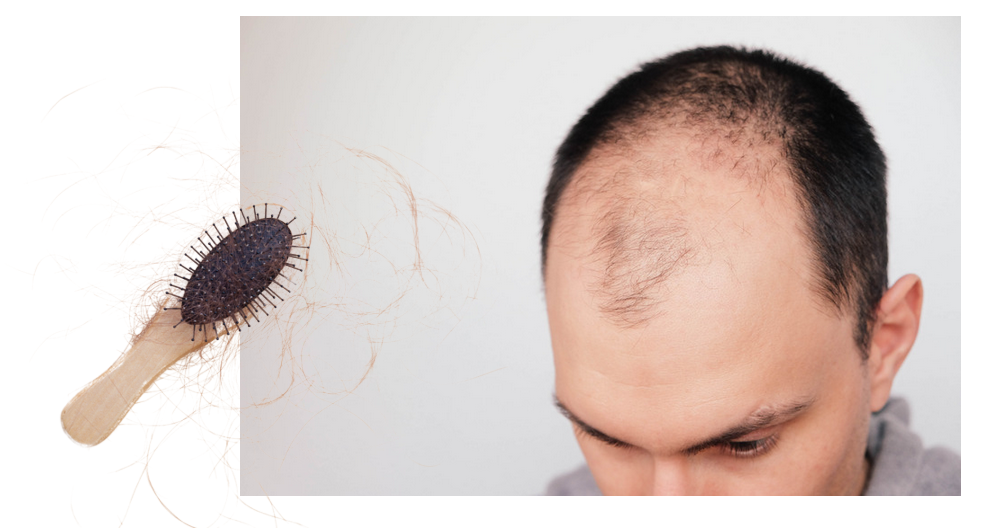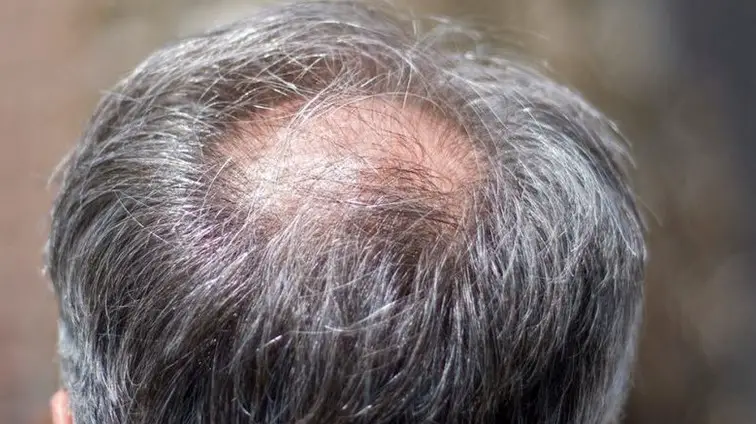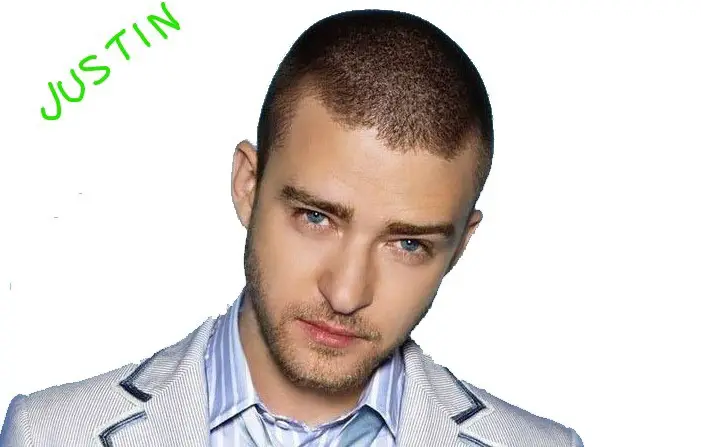Discover the latest advancements in male pattern baldness cure. Explore a comprehensive review of treatments and why is there no cure for male pattern baldness?, from over-the-counter products to surgical procedures, and learn about our exclusive range of products designed to combat hair loss. Start your journey to hair regrowth today with Stages of Balding.
Male pattern baldness, also known as androgenetic alopecia, is a common condition that many men experience at some point in their lives. It’s a topic that’s often shrouded in mystery, with countless myths and misconceptions circulating about its causes and treatments. In this comprehensive guide, we aim to demystify male pattern baldness, providing you with accurate, up-to-date information and practical advice.
Whether you’re noticing your hair thinning for the first time or you’ve been battling hair loss for years, this article is designed to help you understand your condition better and explore the various treatment options available. We’ll delve into the science behind male pattern baldness, debunk common myths, review the effectiveness of different treatments, and even look ahead to the future of hair loss treatment.
If you’ve ever found yourself asking questions like “why is there no cure for male pattern baldness?“, “how to cure male pattern baldness?“, or “will baldness be cured by 2025?“, you’re in the right place. We’ll tackle these questions and many more, providing clear, concise answers based on the latest scientific research.
To enhance your understanding, we’ll also share personal anecdotes from individuals who have successfully managed their hair loss. These real-life stories serve as a testament to the fact that while male pattern baldness can be challenging, it’s not insurmountable.
So, if you’re ready to take control of your hair loss and seek out the best possible treatment, keep reading. This guide is your first step towards a more confident, informed you.
Ready to dive deeper into the world of hair loss and its treatments? Check out our detailed article on Crown Balding Stages to understand the progression of this condition better.
Stay tuned as we unravel the mystery of male pattern baldness and explore the path to potential cures. Let’s embark on this journey together!
Key Insights:
- Male pattern baldness is a widespread issue, primarily influenced by genetics and hormones.
- There isn’t a one-size-fits-all cure, but numerous treatments can manage hair loss and potentially stimulate hair regrowth. These include readily available products, prescribed medications, hair transplant surgeries, and natural remedies.
- The future of hair loss treatment is promising, with research progressing in stem cell therapy, gene therapy, and innovative drugs.
- For a more in-depth understanding of male pattern baldness and its treatment options, delve into our other articles on Stages of Balding.
- Each individual’s experience with hair loss is unique. Therefore, it’s essential to consult with a healthcare provider for personalized advice and treatment.
Note: This article is for informational purposes only and should not replace professional medical advice. Always consult with a healthcare provider for personalized treatment.
Understanding Male Pattern Baldness
Male pattern baldness, or androgenetic alopecia, is a hair loss condition that predominantly affects men. It’s characterized by a specific pattern of hair loss, starting with a receding hairline and progressing to thinning at the crown of the head. Over time, these areas can become completely bald.
The primary cause of male pattern baldness is genetics. If your parents or grandparents have experienced hair loss, you’re more likely to experience it too. This genetic predisposition affects how sensitive your hair follicles are to a hormone called dihydrotestosterone (DHT). High levels of DHT cause the hair follicles to shrink, leading to thinner, shorter hair and eventually, hair loss.
Male pattern baldness can occur at any age, but it’s most common in men in their 30s and 40s. However, it’s not uncommon for men to start noticing hair loss as early as their late teens or early 20s. If you’ve found yourself asking “Why is my hair thinning at 25?“, you’re not alone. Early onset of male pattern baldness is often linked to strong genetic factors.
Understanding the stages of male pattern baldness can help you identify the condition early and seek appropriate treatment. The most commonly used scale to describe the stages of hair loss is the Norwood Scale. It includes seven stages, each representing different degrees of hair loss.
Here’s a brief overview of the Norwood Scale:
- Stage 1: No significant hair loss or receding hairline.
- Stage 2: Hairline starts to recede around the temples.
- Stage 3: Hairline recedes further and forms a “M”, “U”, or “V” shape.
- Stage 4: Hairline recedes more, and there’s noticeable thinning of the hair on the crown.
- Stage 5: Hair loss at both the crown and hairline, which are separated by a band of hair.
- Stage 6: The band of hair disappears, and the crown and hairline merge.
- Stage 7: Only a band of hair going around the sides of the head remains.
For a more detailed look at these stages, check out our article on:
Male pattern baldness is more than just a cosmetic issue. It can have significant psychological impacts, including loss of self-esteem, anxiety, and depression. If you’re struggling with the emotional aspects of hair loss, it’s important to seek help. Talking to a mental health professional or joining a support group can provide comfort and coping strategies.
In the next section, we’ll debunk some common myths about male pattern baldness and discuss why there’s currently no definitive cure. Stay tuned!
Why Is My Hair Thinning at 25?
If you’re in your mid-twenties and noticing your hair thinning, you might be asking yourself, “Why is my hair thinning at 25?“. While it’s true that male pattern baldness is more common in older men, it can start as early as the late teens or early twenties.
The primary factor behind early onset hair loss is genetics. If your father or grandfather started losing their hair at a young age, there’s a higher chance you might too. This is due to the sensitivity of your hair follicles to dihydrotestosterone (DHT), a hormone that can cause hair follicles to shrink and eventually stop producing hair.
However, it’s important to note that not all hair loss in your twenties is due to male pattern baldness. Other factors can contribute to hair thinning, including stress, poor nutrition, certain medical conditions, and even certain hairstyles or treatments that pull on the hair.
If you’re experiencing hair loss in your twenties, it’s crucial not to panic. Remember, early detection is key to managing male pattern baldness effectively. If you notice your hair thinning, it’s a good idea to consult with a healthcare provider or a dermatologist. They can help determine the cause of your hair loss and suggest appropriate treatments.
For more information on early-stage hair loss, check out our article on Iron Deficiency Hair Loss & Early Stage Female Pattern Baldness. Although it focuses on female pattern baldness, it provides valuable insights into early-stage hair loss that can be useful for men as well.
In the next section, we’ll debunk some common myths about male pattern baldness and explain why there’s currently no definitive cure. Stay tuned!
Unravelling the Myths: Why Is There No Cure for Male Pattern Baldness?
When it comes to male pattern baldness, there’s no shortage of myths and misconceptions. One of the most common questions we hear is, “why is there no cure for male pattern baldness?“. To answer this question, we need to delve a bit deeper into the science of hair loss.
Male pattern baldness is primarily caused by genetics and hormones. More specifically, it’s the result of hair follicles’ sensitivity to dihydrotestosterone (DHT), a byproduct of the male hormone testosterone. DHT causes hair follicles to shrink over time, leading to thinner, shorter hair and eventually, hair loss.
The challenge in finding a cure lies in the complexity of these genetic and hormonal factors. Simply put, there’s no one-size-fits-all solution because each person’s genetic makeup and hormonal balance are unique. What works for one person might not work for another.
Moreover, hair growth is a complex process involving various stages – anagen (growth phase), catagen (transitional phase), and telogen (resting phase). Disruptions in any of these stages can lead to hair loss. Therefore, a cure would need to address these disruptions in addition to counteracting the effects of DHT.
Despite these challenges, significant progress has been made in the field of hair loss treatment. While we may not have a definitive cure yet, we have a range of treatments that can effectively manage the condition and even promote hair regrowth in some cases. These include over-the-counter products, prescription medications, hair transplant surgeries, and natural remedies.
In the next section, we’ll provide a comprehensive review of these treatments, helping you understand your options and make an informed decision.
For a deeper understanding of the genetic aspects of hair loss, check out our article on Male Pattern Baldness. It provides a detailed explanation of the role of genetics in male pattern baldness and offers practical advice on managing the condition.
Stay tuned as we continue to unravel the complexities of male pattern baldness and explore the path to potential cures!
Comprehensive Review of Hair Loss Treatments
When it comes to treating male pattern baldness, there’s a wide range of options available. While there’s no definitive cure, these treatments can help manage the condition, slow down hair loss, and in some cases, even promote hair regrowth. Let’s take a closer look at each of these treatments.
Over-the-Counter Products
Over-the-counter products are the most accessible form of treatment for male pattern baldness. These include topical treatments like minoxidil (Rogaine), which works by prolonging the growth phase of hair follicles. Minoxidil is available as a liquid or foam and is applied directly to the scalp. For more information on how minoxidil works, check out our article on Minoxidil for Receding Hairline.
Prescription Medications
Prescription medications for male pattern baldness include finasteride (Propecia) and dutasteride (Avodart). These medications work by blocking the conversion of testosterone to DHT, thereby reducing its levels in the scalp. This can slow down hair loss and even lead to some hair regrowth.
Hair Transplant Surgeries
Hair transplant surgeries involve moving hair from a part of your scalp that has hair to a part that’s balding. There are two main types of hair transplant surgeries: follicular unit transplantation (FUT) and follicular unit extraction (FUE). While these procedures can be quite effective, they’re also more invasive and expensive than other treatments.
Natural Remedies
Natural remedies for male pattern baldness include a healthy diet, regular exercise, and certain supplements. While these remedies may not stop hair loss entirely, they can help maintain overall hair health and slow down the progression of baldness.
Here’s a comparison of these treatments:
| Treatment | Effectiveness | Cost | Side Effects |
|---|---|---|---|
| Over-the-Counter Products | Moderate | Low | Minimal |
| Prescription Medications | High | Moderate | Potential sexual side effects |
| Hair Transplant Surgeries | High | High | Surgical risks |
| Natural Remedies | Low | Low | Minimal |
Remember, Crown Balding Treatments: Our exclusive range of products includes the Regrowth Hair Serum, DHT Blocking Shampoo, Best DHT Blocker Supplement, and Hair Follicle Spray. We also offer Finasteride Prescription Online and a Red Light Therapy Hat. For those interested in natural remedies, we provide a comprehensive Herbs That Stimulate Hair Growth PDF. The effectiveness of these treatments can vary from person to person. It’s important to consult with a healthcare provider to determine the best treatment option for you.
In the next section, we’ll look ahead to the future of hair loss treatment and explore some of the latest research and advancements in the field.
For more information on topical treatments for hair loss, check out our article on Topical Finasteride vs Oral. It provides a detailed comparison of these two forms of finasteride, helping you understand which might be the best option for you.
Stay tuned as we continue our journey into the world of hair loss treatments!
Note: This article is for informational purposes only and should not replace professional medical advice. Always consult with a healthcare provider for personalized treatment.
The Future of Baldness Cure: Will Baldness Be Cured by 2025?
The future of hair loss treatment is a topic that generates a lot of interest and speculation. Many people ask, “will baldness be cured by 2025?“. While it’s impossible to predict the future with absolute certainty, we can look at the current trends and advancements in the field to get an idea of what’s to come.
One promising area of research is the use of stem cells. Scientists are exploring how stem cells can be used to regenerate hair follicles, potentially leading to a cure for baldness. While this research is still in its early stages, the initial results are promising.
Another exciting development is the discovery of new drugs that can potentially treat hair loss. One such drug is SM04554, which is currently being tested in clinical trials. This drug works by targeting the Wnt pathway, a cellular signaling pathway that plays a key role in hair follicle development.
Gene therapy is another area of research that holds promise for the future of hair loss treatment. By targeting the specific genes involved in hair loss, scientists hope to develop treatments that can effectively cure baldness.
While these advancements are exciting, it’s important to remember that developing new treatments takes time. Clinical trials need to be conducted to ensure these treatments are safe and effective. Therefore, while we may not have a cure for baldness by 2025, the future of hair loss treatment looks promising.
In the meantime, there are plenty of effective treatments available to manage hair loss. Whether it’s over-the-counter products, prescription medications, hair transplant surgeries, or natural remedies, there’s likely a treatment option that can work for you.
In the next section, we’ll explore some home remedies for male pattern baldness. These remedies can be a great addition to your hair care routine, helping you maintain your hair health and slow down hair loss.
For more information on the future of hair loss treatment, check out our article on Will Baldness Be Cured by 2025?. It provides a detailed look at the latest research and advancements in the field.
Stay tuned as we continue to explore the world of hair loss treatments and the path to potential cures!
Real Examples of Male Pattern Baldness Cured
While there’s no definitive cure for male pattern baldness, there are numerous examples of individuals who have successfully managed their hair loss and even regrown hair. These “real examples of male pattern baldness cured” serve as a testament to the effectiveness of current treatments and provide hope for those struggling with hair loss.
One such example is John, a 35-year-old man who started noticing his hair thinning in his late twenties. After consulting with a dermatologist, John started using minoxidil and finasteride. Over the course of a year, John noticed a significant reduction in hair loss and even some hair regrowth.
Another example is Mike, a 40-year-old man who opted for a hair transplant surgery after years of struggling with hair loss. The surgery, which involved transplanting hair from the back of his scalp to the balding areas, was a success. Mike now enjoys a fuller head of hair and improved self-confidence.
While these examples are encouraging, it’s important to remember that results can vary from person to person. What works for one person might not work for another. Therefore, it’s crucial to consult with a healthcare provider to determine the best treatment option for you.
In the next section, we’ll explore some home remedies for male pattern baldness. These remedies can be a great addition to your hair care routine, helping you maintain your hair health and slow down hair loss.
For more information on real-life experiences with hair loss treatments, check out our article on Male Celebrities with Receding Hairlines. It provides a look at how some famous individuals have dealt with hair loss, offering insights and inspiration.
Stay tuned as we continue to delve into the world of hair loss treatments and share more success stories!
FAQs about Male Pattern Baldness Cure
In this section, we’ll address some of the most frequently asked questions about male pattern baldness and its treatment. These questions are based on common queries and concerns about this topic.
1. What is the cause of male pattern baldness?
Male pattern baldness is primarily caused by genetics and hormones. More specifically, it’s the result of hair follicles’ sensitivity to dihydrotestosterone (DHT), a byproduct of the male hormone testosterone. DHT causes hair follicles to shrink over time, leading to thinner, shorter hair and eventually, hair loss.
2. What helps men’s hair grow back?
There are several treatments available that can help slow down hair loss and potentially promote hair regrowth. These include over-the-counter products like minoxidil, prescription medications like finasteride and dutasteride, hair transplant surgeries, and natural remedies. For more information on these treatments, check out our article on Male Pattern Baldness Treatments.
3. Will baldness be cured by 2025?
While it’s impossible to predict the future with absolute certainty, the current trends and advancements in the field of hair loss treatment are promising. Researchers are exploring areas like stem cell therapy, gene therapy, and new drugs for treating hair loss. For a detailed look at the future of hair loss treatment, check out our article on Will Baldness Be Cured by 2025?.
4. How to reverse male pattern baldness naturally?
While there’s no definitive natural cure for male pattern baldness, certain lifestyle changes and natural remedies can help maintain overall hair health and slow down the progression of baldness. These include a healthy diet, regular exercise, and certain supplements. For more information on natural remedies for hair loss, check out our article on How to Reverse Male Pattern Baldness Naturally.
Remember, this article is for informational purposes only and should not replace professional medical advice. Always consult with a healthcare provider for personalized treatment. Stay tuned as we continue to explore the world of hair loss treatments and the path to potential cures!
Conclusion
In conclusion, male pattern baldness is a common condition that affects many men worldwide. While there’s no definitive cure for this condition, there are numerous treatments available that can help manage hair loss and in some cases, even promote hair regrowth.
From over-the-counter products and prescription medications to hair transplant surgeries and natural remedies, there’s likely a treatment option that can work for you. It’s important to consult with a healthcare provider to determine the best treatment option based on your specific needs and circumstances.
The future of hair loss treatment looks promising, with advancements in areas like stem cell therapy, gene therapy, and new drugs. While we may not have a cure for baldness by 2025, these advancements provide hope for more effective treatments in the future.
Remember, everyone’s experience with hair loss is unique. What works for one person might not work for another. Therefore, it’s crucial to approach hair loss treatment with patience and persistence.
For more information on male pattern baldness and its treatment, check out our other articles on Stages of Balding. Stay tuned as we continue to explore the world of hair loss treatments and the path to potential cures!
- AI Powered Bald Filter Online 2024: See Yourself with No Hair! - January 19, 2024
- Harklinikken Bad Reviews 2024: Analyzing Negative Feedbacks - January 18, 2024
- How to Get the Alex Eubank Hair | Step-By-Step Tutorial 2024 - January 18, 2024







